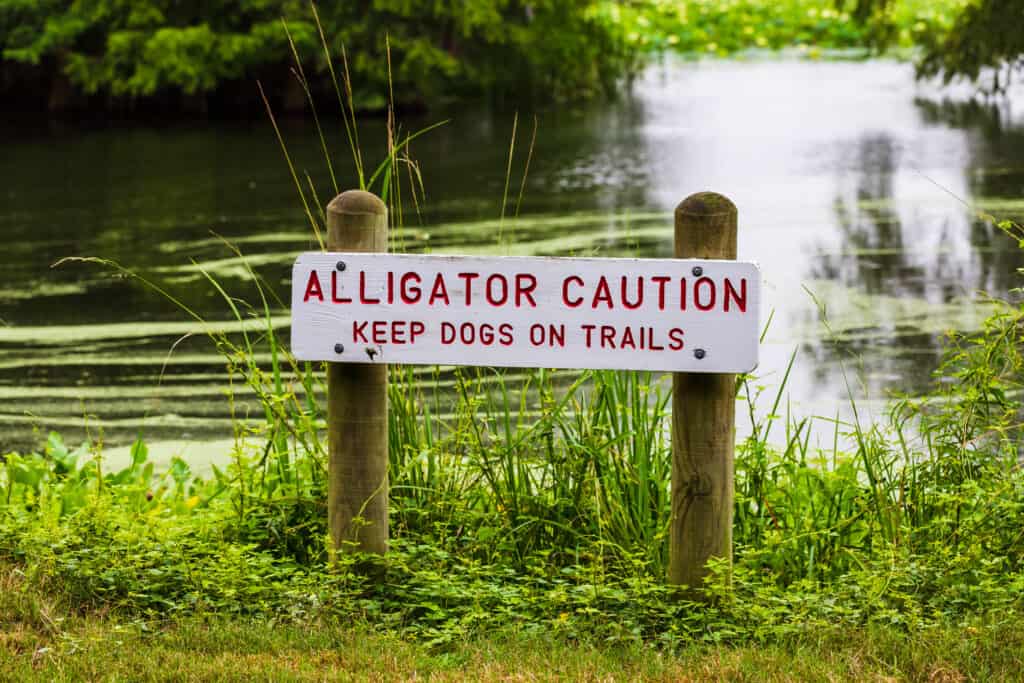Texas is the largest state by land mass in the U.S. after Alaska. It’s home to rattlesnakes, coyotes, and other wild and dangerous creatures. Texas is usually depicted as a dry, desert landscape, so you may be wondering if alligators even live in the state.
Louisiana and Florida are home to the largest populations of alligators in the country. Louisiana has an estimated population of 2 million, and Florida has around 1.3 million. Coming in just behind the two top states is Texas, which has 400 to 500 thousand alligators. They are found across most of the state, but not everywhere. In the next few paragraphs, we’ll explain where to find alligators in Texas, and if it’s safe to go swimming.

Texas is home to 400-500,000 alligators.
©Peter Aronson/Shutterstock.com
Where Do Alligators Live in Texas?
Alligators only live in 10 of the 50 U.S. states. This is because as cold-blooded reptiles, they have to live in places where they get enough external heat to keep them warm. Likewise, in Texas, the reptiles can be found in warmer, southern areas. They avoid the northern and western parts of Texas for the most part. Even though west Texas is warm, it is drier and dustier than the eastern side of the state.
Alligators in Texas range from the Sabine River of East Texas to the Gulf of Mexico, to the Rio Grande, and west to Interstate 35. They are found in the following cities and further east: Dallas, San Antonio, Laredo, Waco, and Austin.
Alligators live in coastal marshes, lakes, and wetlands. They live in freshwater and cannot survive in saltwater because they don’t have salt glands. They require a water source for cooling their skin, catching prey, and nesting. That’s why they stick to the eastern side of the state. They also live in places outside of wild habitats, like residential ponds and lakes. These areas are called pocket habitats. Pocket habitats aren’t usually sustainable long-term residences for these reptiles, as their population expands and requires more room.
Alligators that live amongst humans are at a greater risk of becoming violent. This is because some people feed alligators, which causes them to associate humans with food. This can lead to alligators lunging at humans, especially when they stretch out their hands. Luckily, alligator-human conflicts in Texas are rare and there have been no documented human fatalities in the state from alligators.

Alligators live in coastal marshes, lakes, and other wetland areas. They have to be in or near a water source.
©Sorbis/Shutterstock.com
Lakes and Rivers
Texas Parks & Wildlife states that March 1 through May 30 is the peak season for alligator breeding and nesting. That means they will be most active and most aggressive during these times. That doesn’t mean that you can’t swim during their breeding season, but it’s worth being a little extra cautious at this time.
If you’re planning to swim in Texas, keep in mind that there may be alligators in any body of water. Even though they aren’t often spotted in north Texas, there is a possibility of seeing an alligator anywhere in the state. Texas Parks & Wildlife made a map of the distribution of American alligators in Texas with shading in each county where they are found. If you’re planning to go swimming and are wondering if you have a high chance of seeing an alligator, check the map to find out.
Lake Worth, a popular lake in the Fort Worth Nature Center in Fort Worth, TX has signs posted around it warning that alligators have been spotted there. Many areas that have large alligator populations offer warnings through signs like these so that visitors and residents know to expect to see the reptiles.

Most areas with high alligator populations will display some warning signs to visitors and residents.
©Chad Robertson Media/Shutterstock.com
Is it safe to swim?
Since there have not been any human fatalities from alligator attacks in the state yet, it’s likely safe to swim in recognized swimming areas. There is always a chance of seeing an alligator in the wild because that’s where the creatures live. Even if you see an alligator in a lake or river, it doesn’t mean that you can’t swim there. The reptiles are usually shy and will leave humans alone.
What to Do if You See an Alligator
If you spot an alligator while swimming, it’s best to leave it alone and avoid interacting with it if possible. Alligators in residential areas should be reported to Texas Parks & Wildlife. They will come out and decide if the reptile needs to be relocated to keep humans in the area safe. Likewise, alligators that follow behind boats or maintain a close distance to humans in the water should be reported. They may have been fed and have lost their fear of humans.
Most importantly, don’t kill or harass the alligator. They are a protected species and it is illegal to provoke them. Furthermore, provoking the reptile is how most alligator-caused injuries occur, so it’s best to leave the handling to experts.

Feeding alligators is illegal and extremely dangerous, it can cause them to lose their fear of humans.
©Tande/Shutterstock.com
The photo featured at the top of this post is © Danita Delimont/Shutterstock.com
Thank you for reading! Have some feedback for us? Contact the AZ Animals editorial team.






